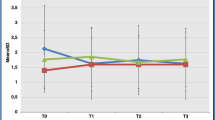Abstract
Purpose
Taste perception is often affected after stapes surgery despite effort to preserve chorda tympani nerve. The aim was to examine changes of particular taste qualities and their recovery after operation of otosclerosis.
Materials and methods
Taste function was prospectively investigated with a questionnaire and a taste strip test (TST) preoperatively, 3–5 days and 1 year after stapes surgery with the preservation of CTN.
Results
In the early postoperative examination, 34/42 patients had a lower TST score, 7/42 decrease of taste in the questionnaire. One year after surgery, 11/42 patients had a lower TST score, 1/42 patients decrease of taste in the questionnaire. The most pronounced decrease in the TST score was in sweet (− 1.76 points, p < 0.001), followed by bitter (− 1.71 points, p < 0.001), salty (− 1.64 points, p < 0.001) and sour taste (− 1.33 points, p < 0.001). The sour taste had a significant lower alteration compared to others. Men had significantly pronounced alteration in salty taste compared to women. The complete recovery was proved in bitter taste. Better recovery in bitter taste was observed in patients younger than 45 years of age.
Conclusions
Gustatory changes after stapes surgery are mostly transient with different impairment and recovery rate for particular taste qualities. A sour taste seems to be relatively resistant to damage. The best recovery rate is in a bitter taste, especially in younger patients.
Similar content being viewed by others
References
Acar GO, Kivekäs I, Hanna BM et al (2014) Comparison of stapedotomy minus prosthesis, circumferential stapes mobilization, and small fenestra stapedotomy for stapes fixation. Otol Neurotol 35(4):123–129
Skrivan J, Betka J, Kuchar M et al (2005) Kratkodobe a dlouhodobe funkcní vysledky stapedoplastik [Short-term and long-term functional results of stapedoplasty]. Otorinolaryng a Foniat Prague 54(2):87–90
Cheng HCS, Agrawal SK, Parnes LS (2018) Stapedectomy versus stapedotomy. Otolaryngol Clin N Am 51(2):375–392
Mueller C, Kallert S, Renner B et al (2003) Quantitative assessment of gustatory function in a clinical context using impregnated “taste strips.” Rhinology 41(1):2–6
Krarup B (1958) Taste fibres and the chorda tympani. Acta Otolaryngol Suppl 140:201–205
Sakagami M, Sone M, Tsuji K et al (2003) Rate of recovery of taste function after preservation of chorda tympani nerve in middle ear surgery with special reference to a type of disease. Ann Otol Rhinol Laryngol 112:52–56
Michael P, Raut V (2007) Chorda tympani injury: operative findings and postoperative symptoms. Otolaryngol Head Neck Surg 136(6):978–981
Skoloudík L, Vokurka J, Simakova E (2012) Mechanical treatment and autoclaving of middle ear ossicles from cholesteatomatous ears. Cent Eur J Med 7:194–197
Ziylan F, Smeeing DPJ, Bezdjian A et al (2018) Feasibility of preservation of chorda tympani nerve during noninflammatory ear surgery: a systematic review. Laryngoscope 128(8):1904–1913
Stillman JA, Morton RP, Hay KD et al (2003) Electrogustometry: strengths, weaknesses, and clinical evidence of stimulus boundaries. Clin Otolaryngol Allied Sci 28:406–410
Landis BN, Beutner D, Frasnelli J et al (2005) Gustatory function in chronic inflammatory middle ear diseases. Laryngoscope 115(6):1124–1127
Guder E, Böttcher A, Pau HW et al (2012) Taste function after stapes surgery. Auris Nasus Larynx 39(6):562–566
Berteretche MV, Eloit C, Dumas H et al (2008) Taste deficits after middle ear surgery for otosclerosis: taste somatosensory interactions. Eur J Oral Sci 116(5):394–404
Maeda E, Katsura H, Nin T et al (2018) Change of somatosensory function of the tongue caused by chorda tympani nerve disorder after stapes surgery. Laryngoscope 128(3):701–706
Berling Holm K, Knutsson J, Strömbäck K et al (2017) Taste disturbance after stapes surgery: an evaluation of frequency, severity, duration, and quality-of-life. Acta Otolaryngol 137(1):39–43
Celis-Blaubach A (1970) Chordal dysgeusia. Arch Otolaryngol 92:76–79
Ciofalo A, Zambetti G, Romeo M et al (2015) Taste and olfaction in middle ear surgery. Ann Otol Rhinol Laryngol 124(4):312–316
Danielidis V, Skevas A, Van Cauwenberge P et al (1999) A comparative study of age, and degree of facial nerve recovery in patients with Bell’s palsy. Eur Arch Otorhinolaryngol 256:520–522
Sone M, Sakagami M, Tsuji K et al (2001) Younger patients have a higher rate of recovery of taste function after middle ear surgery. Arch Otolaryngol Head Neck Surg 127(8):967–969
Nishii T, Nin T, Maeda E et al (2020) Earlier recovery of lingual dysfunction after middle ear surgery in pediatric versus adult patients. Laryngoscope 130(4):1016–1022
Author information
Authors and Affiliations
Corresponding author
Ethics declarations
Conflict of interest
All the authors certify that they have no affiliations with or involvement in any organisation or entity with any financial interest (such as honoraria; educational grants; participation in speakers’ bureaus; membership, employment, consultancies, stock ownership, or other equity interest; and expert testimony or patent-licensing arrangements), or non-financial interest (such as personal or professional relationships, affiliations, knowledge or beliefs) in the subject matter or materials discussed in this manuscript.
Ethical approval
The study was conducted according to the guidelines of the Declaration of Helsinki on Biomedical Research Involving Human Subjects. The subjects gave written informed consent. The study was approved by the Institutional Ethical Committee (No. 202002 S16).
Additional information
Publisher's Note
Springer Nature remains neutral with regard to jurisdictional claims in published maps and institutional affiliations.
Rights and permissions
About this article
Cite this article
Skoloudik, L., Krtickova, J., Haviger, J. et al. Changes of taste perception after stapes surgery: a prospective cohort study. Eur Arch Otorhinolaryngol 279, 175–179 (2022). https://doi.org/10.1007/s00405-021-06665-0
Received:
Accepted:
Published:
Issue Date:
DOI: https://doi.org/10.1007/s00405-021-06665-0




